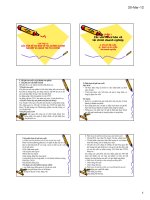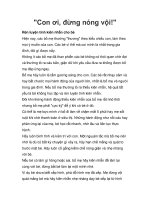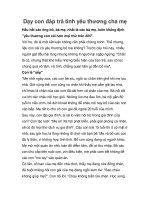Number - Bingo! pot
Bạn đang xem bản rút gọn của tài liệu. Xem và tải ngay bản đầy đủ của tài liệu tại đây (244.96 KB, 39 trang )
Number - Bingo!
Number - Bingo!
Language
Aims:
To revise numbers (or certain
vocabulary fields, time of day,
vocabulary)
Time:
8 minutes
Preparation:
Prepare a 5x5 grid with either
• 25 numbers in each square
• nothing in it (blanc)
Procedure:
The teacher calls out a number he/she
draws from a box. If a student has this
number, he/she puts a little scrap on the
number. The teacher goes on until a
student gets five in a diagonal or
horizontal row. Bingo!
Variation:
Prepare a 5x5 grid with
• 25 words in each square (for example
25 words of one unit). Make enough
variations of these grids so each
student has one that is slightly
different.
While it may seem time-consuming to make the grids, they
can be used over and over. This game is received very
enthusiastically because often, students are already familiar
with it. It is great as a warmup activity and can have many
variations (past-participle,)
© by Anja Schindler ;-)
Who am I??
Who am I??
Language
Aims:
To practice learned vocabulary. To
construct Yes / No questions and short
Yes / No replies.
Time:
10 minutes
Preparation:
Either:
• Cut out pictures or photographs of
famous people from magazines or
newspapers.
Or:
• Write the names of famous people
(mixed nationalities) on small pieces
of paper.
Procedure:
There are two ways to
play this game (depending
on the size of your
learner group)
1. Tape a name on the forehead of each
student. The individual student should
not see his or her paper, but the
others should.
2. Then, like with 20 questions, only yes
or no questions should be asked.
Perhaps start with yourself and ask
"Am I am man?" If the answer is yes, I
can ask again, but if the answer is no,
it's the next person's turn.
3. Play until everyone has guessed who
he or she is!
Variation:
1. Give each student a picture of a
famous person. Tell the students that
they are the person in the picture they
are holding. Tell them not to let
anyone see their picture.
2. Divide the students into pairs.
3. One of the students in each pair tries
to guess who their partner is by
asking Yes / No questions. For
example, Are you a man? Are you an
actor? Are you from Hong Kong?
The partner answers in short Yes / No
answers. (e.g. Yes, I am; No, I'm not.)
4. The student asking the questions
continues asking questions until he /
she correctly guesses who their
partner is. Remind them that they
can only ask Yes / No questions even
if they think they know the answer
(You are Julia Roberts. (wrong) Are
you Julia Roberts? (correct)).
5. When the first student has guessed
the famous person correctly, partners
change roles and repeat Steps 3 and
4.
This can be played with nationalities, countries, household
objects, food, … anything and it's a gas
Simon Says
Simon Says
Language
Aims:
To review vocabulary for parts of the
body. To review motion verbs that are
used with parts of the body. To practice
listening to instructions.
Time:
10-15 minutes
Preparation:
none.
Procedure:
1. Move all of the desks to the sides of
the room and have the students stand
near the center of the room, about an
arm's length apart.
2. Tell the students your name is
Simon. You, as Simon, give instructions
to the students. They are to do what you
instruct only when you begin the
instruction with "Simon says " (e.g.
"Simon says, 'Touch your nose.'"). If you
begin a command differently (e.g. You
only say, "Touch your nose.") then the
students are not to obey your
command. In other words, students
should only respond to your command if
you begin with "Simon says, "
3. As Simon you continue giving
instructions to students telling them to
touch, close, raise, etc. different parts of
the body, making sure to mix up proper
commands (e.g. "Simon says, 'Touch
your nose.'") with improper commands
(e.g. "Touch your nose.")
4. A student who responds to an
improper command must leave the
game and sit down.
5. The last student left standing is the
winner.
The degree of difficulty of this game is left entirely up to you,
the teacher. You can give commands slowly or quickly. You
can correctly or incorrectly point to parts of the body, ensuring
students listen carefully to what you say. And finally, if you
wish to be really tricky, you can point to parts of the body on
improper commands.
Some example commands are listed below.
"Simon says, 'Close your eyes.'"
"Simon says, 'Scratch your head.'"
"Simon says, 'Raise your right arm.'"
"Simon says, 'Touch your toes.'"
"Simon says, 'Fold your arms.'"
Find A Good Match
Find A Good Match
Language
Aims:
To review vocabulary and phonetic
transcription.
Time:
10 minutes
Preparation:
Prepare enough palm cards so that each
student will have one. On half of the
cards, write vocabulary items your
students have seen recently. On the
other cards, write those same words
phonetically.
Procedure:
1. Hand out one card to each
student and get students to find
their new partner and sit down
together.
2. Tell each pair to look at their
word and work out what it
means.
3. Ask each pair what their word is and
what it means.
Variation:
For a slightly more challenging, but
longer, feedback, get each pair to give a
definition of their word. The other
students have to guess what the word is
Hangman
Hangman
Language
Aims:
To review vocabulary
Time:
10 minutes
Preparation:
none
Procedure:
1. Divide the class into two teams.
2. On the blackboard, draw spaces for
the number of letters in a word.
3. Have the players guess letters in the
word alternating between the teams.
If a letter in the word is guessed
correctly, the teacher writes it into the
correct space.
If a letter is guessed which is not in
the word, the teacher draws part of
the man being hanged.
The team which can guess the word
first receives a point, then start the
game over.
Word Grab with Songs
Word Grab with Songs
Language
Aims:
To review vocabulary and it is a
wonderful activity if you think your class
needs waking up a little.
Time:
8 minutes
Preparation:
Choose a song that the students have or
have not heard before. Choose 10-15
pieces of vocabulary from the song and
write them on separate pieces of paper.
Procedure:
1. Pronounce the words with the
students first.
2. Stick each word to the board
with magnets.
3. Put the students into 2 teams
each one in a line before the
board.
4. Play the song.
5. When the 2 students at the front of
their line hear a word in the song that
is on the board they must race each
other to grab that word from the board
6. They then go to the back of the line
and it's up to the next pair.
7. The team with the most words wins.
Variation:
Be careful this can get quite violent!
I don't usually stop the tape so don't
choose words that come one after the
other. If you want to make it more
difficult you can put red herrings up. You
can usually play the song a couple of
times until they get all the words
.
A MEMORY GAME
A MEMORY GAME
Language
Aims:
To revise vocabulary and to train
memory
Time:
8 minutes
Preparation:
none
Procedure:
1. The teacher starts with the sentences:
In my suitcase there is a toothbrush
(for example).
2. Student A finds an own word and
goes on: In my suitcase there are a
toothbrush, …
3. Student B repeats what A said and
completes it with an own word.
4. Play until everybody has tried to
remember all the words or until one
student makes a mistake.
Am I a pizza?
Am I a pizza?
Language
Aims:
To review vocabulary. To use yes/no
questions to figure out unseen words.
Time:
10-15 minutes
Preparation:
Cut out little strips of paper or use post-it
notes and write vocabulary words on
each piece. You might also need sticky
tape.
Procedure:
1. Tell all the students to stand up in the
center of the classroom.
2. Place a piece of paper with a
previously taught vocabulary word on
the back of each student so the
student cannot see it.
3. Tell the students to walk around the
classroom and ask other students
yes/no questions to try to figure out
what the word on their back is. Tell
the students they can only ask three
questions to one person, then they
have to move on to another person.
It might go something like this:
"Am I a person?" "No."
"Am I an animal?" "No."
"Am I food?" "Yes."
(Move on to the next student.)
"Am I cheese?" "Erm not exactly."
"Am I made from cheese?" "Yes."
"Am I a sandwich?" "No."
(Move on to the next student.)
"Am I a pizza?" "Yes!"
4. After a student has guessed his/her
word correctly, he/she can continue to
circulate and answer other students'
questions.
5. The activity is finished when
everyone has guessed his/her word.
Chain Game
Chain Game
Language
Aims:
To recall learned vocabulary. To
practise listening for the last sound at
the end of words. To pronounce clearly
so other students can understand.
Time:
10-15 minutes
Preparation:
none
Procedure:
1. Ask a student to tell you a word they
have learned from their lessons.
Write the word on the board or OHP.
2. Underline the last letter of that word
and ask the students to find a new
word starting with that letter.
3. Repeat this process until you are
satisfied with the number of words
students have produced.
Variation
Place students into two relay teams.
The students should line up (either
standing or sitting) according to the
order that they will follow. Tell students
this is a timed relay race and that they
need to work fast. Tell the first student
to shout out any word. The second
student carefully listens to that word and,
in particular, for the last letter of that
word. The second student then shouts
out a new word that begins with that last
letter. The third student then continues
the process until all the students have
given a word. (Depending on the size of
your class, you may wish to have the
students go twice round instead of once,
as this activity can be very short.) You
record how long it took the team to go
once or twice round. Put their time on
the board or OHP for the other team to
see. The other team must beat this time
to win.
Describe me
Describe me
Language
Aims:
To write the structures (i.e. present and
present continuous tense) and
vocabulary necessary to describe people
in photographs.
Time:
10 – 15 minutes
Preparation:
Cut out photos from magazines,
newspapers, etc. so that each student
has one photograph to look at and
describe.
Procedure:
1. Give every student a photograph
of a person.
2. Ask each student to write a
description of the person in the photo,
being sure to describe his / her
appearance and clothing.
3. When all of the students are
finished writing, collect their writing.
4. Display all of the photos on the
white board. Give each person in the
photographs a name. Write the name
above the photo.
5. Read the descriptions from the
students one at a time. When a
student thinks he / she knows which
photo is being described, he / she
shouts the name of the person in the
photo.
6. The student who has guessed the
most people correctly is the winner.
Variation
As a variation, students can be divided
into two teams and members of each
team are allowed to shout the names. A
student who answers correctly scores
one point for his / her team. If a team
guesses incorrectly, the other team gets
to try and guess. If neither team
guesses correctly, continue to read out
the description, and once again, both
teams are allowed to guess. The team
with the most points at the end is the
winner.
I spy
I spy
Language
Aims:
To review classroom vocabulary.
Time:
10 - 15 minutes
Preparation:
None
Procedure:
1. Pick something from the classroom
for the students to try to identify (e.g.
"clock") and then write on the board: I
spy with my little eye something that
begins with a 'c'. Ask the students to
find something in the the classroom
that begins with the letter 'c'. Allow
students to continue guessing until
someone guesses correctly.
2. Ask the student who guessed
correctly to look for something in the
classroom for the other students to
identify. After he/she has picked
something (e.g. "window") he/she
says, "I spy with my little eye
something that begins with a 'w'. The
students try to find things that begin
with the letter 'w' and continue
guessing until someone guesses
correctly.
3. Repeat Step 2 until most or all
students have had a turn.
Missing vowels
Missing vowels
Language
Aims:
To review vocabulary and target
language. To use contextual clues to fill
in missing letters of words.
Time:
10 - 15 minutes
Preparation:
Select or create a short paragraph and
take all the vowels out of the words
replacing them with a dash or line. This
can easily be done on the word
processor by using the Find and
Replace tool. The paragraph can: 1. be
one you have worked on before; 2.
introduce something you're going to do
in class that day; 3. be a list of
commonly used classroom expressions;
or 4. be about your weekend, holiday,
etc.
Example: T_d_y w_s v_ry h_t. _t r_
_ch_d 35 d_gr_ _s C_ls_ _ s. _
w_sh _ h_d _ sw_mm_ng p_ _l.
Procedure:
1. Give the students the paragraph with
the vowels taken out of all of the
words.
2. Tell the students to fill in the missing
vowels.
3. When they have finished, have the
students write the paragraph on a
piece of paper.
Number Toss
Number Toss
Language
Aims:
To practice numbers from for example 0
to 10.
Time:
10 minutes
Preparation:
You need a small ball such as a tennis
ball.
Procedure:
1. Ask students to stand up and
make a circle.
2. Tell the students you will throw
the ball to one of the students. That
student catches the ball and then
says any number between 0 and 10
(e.g. "4")
3. The student on the right must
then say the number that comes after
(i.e."5"). The student on the left says
the number before (i.e."3"). Note: If
the student who has the ball says the
number 10, the student on the right
says "0" and the student on the left
says "9". It is probably a good idea to
practice this first to make sure
students understand the rules of the
game.
4. After the students say the
numbers, the student who caught the
ball throws it to another student and
Steps 2 and 3 are repeated. If a
student says an incorrect number,
he/she must leave the circle.
5. The last student(s) left standing
wins.
Running dictation
Running dictation
Language
Aims:
To practice reading, writing, speaking
and listening.
Time:
15 minutes.
Preparation:
Cut a suitable text into four (or more)
pieces and attach the pieces on the wall
somewhere in the classroom so that the
students can easily see it.
Procedure:
1. Put the class into pairs. Tell students
to prepare pen and paper.
2. Pin or tape a few copies of the chosen
text either on the classroom walls or just
outside the class. Students should not
be able to read the text from their seats.
3. Explain that this is a race. Student 'A'
should get up and run to the text, then
read and remember as much as they
can. After this they must return to
student 'B' and dictate what they have
remembered. Student 'B' then writes
this down. Students should change
roles half way through the text. The
first pair to rewrite the text (without
spelling or other errors !) is the
winner.
Word race
Word race
Language
Aims:
To review vocabulary or grammar points
from previous lessons (e.g. tense forms,
vocabulary of description, general
knowledge, prepositions, etc.)
Time:
15 - 20 minutes
Preparation:
Write down the questions you plan to
ask the students. Move desks to the
sides of the classroom.
Procedure:
1. Divide the class into two or three
teams of equal numbers. The
students to bring the chairs out into
the middle of the room.
2. Each team should form a row;
students sit in chairs one behind the
other to form a line perpendicular to
the white board.
3. Assign each member of the
teams a number from 1 (front of the
row) to the maximum number of
team members (the end of the row).
4. Ask a question and then say a
number. For example, "What is the
opposite of 'up'? Number 5." The
student who is number 5 on each
team runs to the board to write the
answer. The first correct answer
gets a point for his/her team.
Pushing, stealing the other team's
pen, and erasing the other team's
answer is subject to penalty.
Mime
Mime
Language
Aims:
To review word fields (transportation,
job, moods, animals, …)
Time:
10 - 15 minutes
Preparation:
Make a list of 8 - 10 modes of
transportation. Include the verb that
goes with the noun (e.g. ride a bicycle;
drive a car; fly a plane).
Procedure:
1. Select a student to come up to the
front of the class. Show the student the
first phrase (e.g. ride a bicycle). Do not
let the rest of the class see it.
2. Tell the student to act out that action
without using any words or sounds.
Encourage the student to exaggerate the
action.
3. The other students try to guess
verbally what he/she is doing by making
a sentence in the present continuous
tense (e.g. "You are riding a bicycle.").
4. The student who says the complete
sentence correctly then gets to select a
classmate to go up and act out the next
phrase.
Variation
You can do this activity with all kinds of
word families. Or let the student mime
what they had for dinner last night.
Vocabulary Anagram
Vocabulary Anagram
Language
Aims:
A simple activity to expose students to a
particular lesson topic and to help them
recall and expand their vocabulary.
Time:
10 minutes
Preparation:
None
Procedure:
1. Put the class into pairs or groups
of three.
2. Write the phrase 'Happy New
Year' (or any other word or phrase of
your choice) on the board and tell
students that they have five minutes
to make as many words as possible
from the letters in Happy New Year.
They can only use the letters once
and may not add any letters that are
not in the word or phrase.
3. Explain that the group with the
most words wins. At the end of 5
minutes ask the groups to count their
words to determine the winner.
Check the winning groups answers. The
group to call out the words whilst you
write them on the board. You may
also like to follow up by inviting other
members of the class add other words
that the winning group missed.
Variation
Ask your students to write a story that
includes all the words on the board.
What’s that?
What’s that?
Language
Aims:
To review the names of things found in a
classroom.
Time:
10 minutes
Preparation:
Look around the classroom and make a
list of the names of about ten items.
Procedure:
1. Tell students you're going to do a
quick vocabulary quiz with them so
they need to have a pen and a piece
of rough paper.
2. Tell them that you will point to
something in the room and they must
write down the English word for that
object. (They are not allowed to talk or
share answers with other students or
use their dictionaries.)









